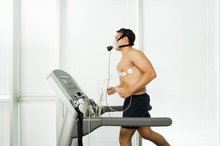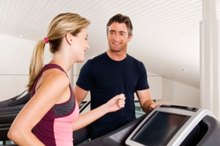The Ebbeling Treadmill Test
The Ebbeling Treadmill was developed in 1991 as a submaximal walking test to assess volitional oxygen intake, otherwise known as VO2 max. Many VO2 max tests are administered in a clinical setting because they actually take you to fatigue on the exercise apparatus. The Ebbeling test is a safe and simple test that only requires a treadmill and a heart rate monitor, so it is easy to administer. It is considered a submaximal test because it lasts a given duration and does not fully fatigue you. The results are plugged into an equation for an estimation of your VO2max. Since the results are simply an estimate, talk to your doctor about getting a maximal VO2 test if you need a more accurate number.
VO2max
Maximal volitional oxygen intake, or VO2max, is a measurement of how much oxygen your body can use to convert stored energy into usable energy. This measurement is generally expressed as milliliters per kilogram of bodyweight per minute, or ml/kg/min. The more oxygen you can use, the healthier you are considered to be. According to Joseph Warpeha, a certified strength and conditioning coach, VO2max is thought to be the best predictor for health, fitness and athletic performance. The American Council on Exercise recommends that you get routine VO2max tests as you get older, in addition to maintaining a consistent cardiovascular exercise schedule 1.
- Maximal volitional oxygen intake, or VO2max, is a measurement of how much oxygen your body can use to convert stored energy into usable energy.
- The American Council on Exercise recommends that you get routine VO2max tests as you get older, in addition to maintaining a consistent cardiovascular exercise schedule 1.
Protocol
How to Calculate VO2 Reserve
Learn More
Do a two-minute to four-minute warm-up to find a comfortable walking speed between 2 and 4.5 mph that raises your heart rate to 50 to 70 percent of your maximum heart rate. To figure out your max heart rate, take 220 minus your age. For a 40-year-old person, the maximum heart rate is 180 beats per minute, so 50 to 70 percent of 180 bpm is 90 to 126 bpm. To do the test, walk at the pace determined during warm-up with a 5 percent incline for four minutes. Record the average heart rate during the last 30 seconds of the test.
- Do a two-minute to four-minute warm-up to find a comfortable walking speed between 2 and 4.5 mph that raises your heart rate to 50 to 70 percent of your maximum heart rate.
Equation
To figure out VO2max from the test, certain data needs to be plugged into an equation. The equation, provided by the Canadian Society for Exercise Physiology is VO2max = 15.1 +21.8 (speed in mph) - 0.327 (heart rate in bpm) - 0.263 (speed x age in years) + 0.00504 (heart rate in bpm x age in years) + 5.98 (gender: female = 0, male = 1). So if a 30 year old female walked on the treadmill at 4.0 mph with a heart rate of 145 in the last 30 seconds, her VO2max would be 45.25 ml/kg/min.
Conclusions
Treadmill Ramp Test Protocol
Learn More
The National Strength and Conditioning Association states that the average VO2max for males aged 20 to 39 should be 41.0 to 42.5 ml/kg/min. An above average VO2max range is 44.6 to 46.8 ml/kg/min while an excellent VO2max is over 50.4 ml/kg/min. A VO2max below 32.5 ml/kg/min is considered below average. For females aged 20 to 39, average VO2max should be between 33.8 and 35.2 ml/kg/min. Above average VO2max range is between 36.7 and 38.1 ml/kg/min and an excellent VO2max is over 41.0 ml/kg/min. Below 26.5 ml/kg/min is considered below average.
- The National Strength and Conditioning Association states that the average VO2max for males aged 20 to 39 should be 41.0 to 42.5 ml/kg/min.
- An above average VO2max range is 44.6 to 46.8 ml/kg/min while an excellent VO2max is over 50.4 ml/kg/min.
Related Articles
References
- "Advanced Health and Fitness Specialist Manual”; American Council on Exercise; 2009
- Lippincott’s Nursing Center: The Ebbeling Protocol
Writer Bio
Riana Rohmann has been working for the Marine Corps doing physical training and writing fitness articles since 2008. She holds personal trainer and advanced health and fitness specialist certifications from the American Council on Exercise and a Bachelor of Science in kinesiology and exercise physiology from California State University-San Marcos.








